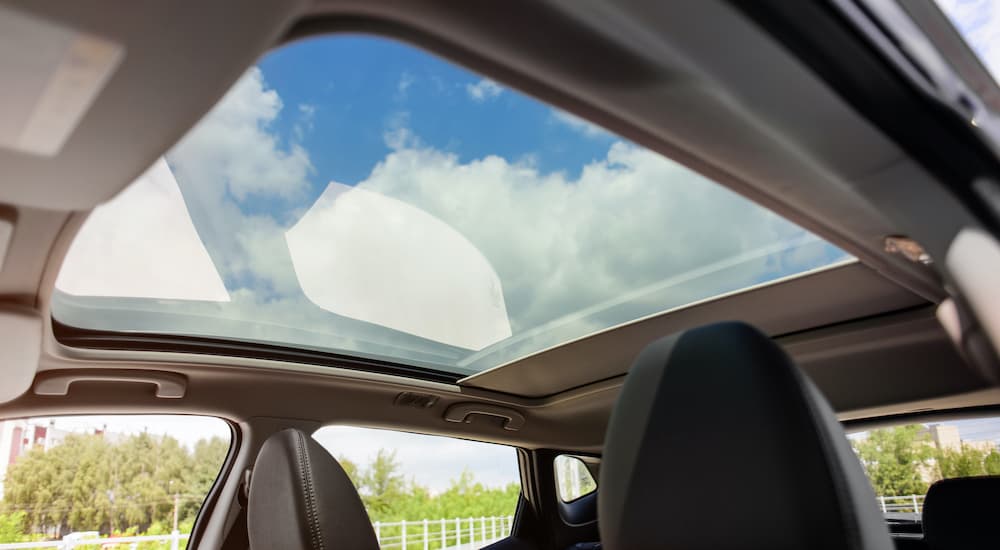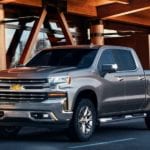You’ve likely heard the tale of the “Three Little Bears,” where Goldilocks makes herself at home while the bears are away. She tests their chairs, bowls of porridge, and beds, deeming one too hot or too cold or too soft or too firm, before discovering that baby bear’s things are just right. It’s a story with a moral lesson, but the act of searching for something that is “just right” is prevalent in the automotive industry and models like the 2023 Chevy Traverse. Think it’s too much of a stretch? Trust me on this.
For 2023, Chevy updates the Traverse with the SkyScape dual-panel sunroof with a powered rear sunshade. The sunroof is available on the LT Leather and Premier trims and standard on the High Country. The addition opens the SUV’s cabin and delivers an open-air experience to the driver and passengers, circulating the air and providing a stunning and expansive view of the sky. However, getting to this sunroof is the product of years of drivers looking for the Goldilocks standard––a driving experience that was “just right.” What do I mean?
The Goldilocks Dilemma
The automobile replaced the trusty steed, giving drivers a more efficient way to travel. However, the first automobiles were nothing more than open carriages with engines, leaving drivers exposed to the elements much like they were on their horses. Fortunately, it wasn’t long before people started tinkering with their automobiles, enclosing the carriages with tarps to keep themselves, their passengers, and cargo dry and warm.
As the automobile progressed and automakers like Cadillac offered fully enclosed models, drivers fell into two categories. They either fully appreciated the cabin and its protection or, like Goldilocks, were on the hunt for something “just right.” These drivers wanted the option of opening the vehicle to the elements but only when they deemed fit. Thus, the sunroof was born, and the industry’s Goldilocks dilemma was solved. Now, sunroofs are prevalent in many models, including the 2023 Chevy Traverse.
Origins of the Sunroof
The sunroof made its official debut in London in 1925 when Noel Mobbs patented a sliding roof panel he named the “Pytchley.” The Pytchley gained momentum among automakers like Daimler and inspired competition with rivals like Vauxhall, who introduced the Sunshine Roof in 1937. The Sunshine Roof was a notable improvement over the Pytchley, so much so that a legal battle ensued until the British courts ordered Vauxhall to pay damages to Mobbs for stealing his design.
Despite the lawsuit, the sunroof gained momentum and eventually made its way to major automotive brands like Buick, Cadillac, and Oldsmobile throughout the late 1930s and early 1940s. The design, a simple sliding roof panel, was developed and patented by a subsidiary of GM known as the Ternstedt Manufacturing Company and was only available as a special order.
Around the same time, renowned blacksmith Traugott Golde of Germany designed a sunroof that he marketed under his family’s business, Golde Patent Top Manufacturing Company. Golde patented the canopy roof in the American market and improved the sunroof, adding a cable drive mechanism that drivers could operate with a hand crank or via an electric motor. This was another vast improvement over the Pytchley roof, earning the Golde sunroof an audience with BMW, Volkswagen, and Porsche. Shortly after, Golde ventured to the United States, settling in Detroit and landing a massive deal with Studebaker and Ford.
Golde designed a siding panel sunroof for Ford’s 1960 Thunderbird, which made history as the first car in post-war America to come from the factory with a sunroof. Ford heavily marketed the new design, but the high cost of the upgrade added to expensive options, like power windows and air conditioning, priced the Thunderbird out of most Americans’ budgets. By 1961, Ford dropped the option, but fortunately, that wasn’t the end of the sunroof for America’s leading automaker.
The Makings of the Modern Sunroof
Thankfully, the modern sunroof is legions beyond the Pytchley and Golde designs. So, how did the industry get from a heavy sliding roof panel to the sunroof we know today? We have the American Sunroof Company to thank for this dramatic transformation.
German-born engineer Heinz Christian Prechter showed a mechanical aptitude at an early age, eventually earning acceptance into the Ohm Polytechnic Engineering School in Nuremberg. While there, he became close friends with Hans-Dieter Golde of the renowned Golde family. He was enamored by the family’s ingenuity, specifically the sunroof. He took that passion to the United States, where he joined the Golde business as a distributor on the West Coast.
Prechter teamed up with a local automotive shop, convincing the owner to carry and install the Golde sunroof kits. The partnership blossomed into the American Sunroof Company (ASC), eventually phasing out the Golde sunroof with Prechter’s design. By the 1960s, the company was renowned among Los Angeles elites, serving customers like Steve McQueen and Frank Sinatra. These celebrities helped ASC build name recognition, eventually catching the attention of Ford Motor Company, who tasked the company with outfitting the 1967 Thunderbird with a sunroof.
Learning from past mistakes, the 1967 Thunderbird promised a new design that was more affordable and easier to operate. ASC made that possible, equipping the icon with an electrically powered sunroof. More importantly, ASC minimized costs by installing the sunroofs at their facility rather than on Ford’s assembly line, minimizing risk for Ford so that they could pass the savings onto the customer. This time, the risk was worth the reward.
A New Trend Takes Over
Ford’s non-exclusive arrangement with ASC meant that other automakers could join the craze, leading ASC to partnerships with Cadillac and Dodge. Before long, sunroofs were no longer relegated to luxury models as ASC’s in-house installation made them more accessible to the masses. By the 1970s, you could get a sunroof installed on everything from a Chrysler and Buick to a Cadillac and beyond. More importantly, automakers like Chrysler found ways to cut costs and asked ASC to develop modular sunroof kits that they could install on the Chrysler assembly line. This knocked hundreds of dollars off the price, sending sales skyrocketing in a trend that continues even today.
Delivering the “Just Right” Driving Experience
Today, the modern sunroof has dramatically progressed from the simple design of the 1970s to an array of options, like the dual panel SkyScape sunroof you’ll find on the 2023 Chevy Traverse. There are built-in, spoiler, and pop-up roofs, lamella roofs that open like Venetian blinds, and panoramic roofs that open up the cabin to give the vehicle an airy and spacious feel. Each design has its advantages, with many automakers now relying on panoramic roof designs for a truly dramatic aesthetic.
Whatever the design, sunroofs embody the Goldilocks dilemma in her quest to find something “just right for her.” The first automobiles still exposed drivers to the elements just like their trusty steeds, giving cars only the advantage of faster travel. However, as automakers like Cadillac enclosed their models, drivers found themselves looking for more, for something just right.
Sunroofs were designed to give drivers the best of both worlds. The Pytchley and Golde models answered that need with their simplistic and utilitarian designs. However, the American Sunroof Company took those designs to the next step and helped popularize the sunroof among American drivers. In exchange, drivers discovered they could have it all, mimicking Goldilocks’ joy when she found that the baby bear’s chair, bed, and porridge were all “just right.”






